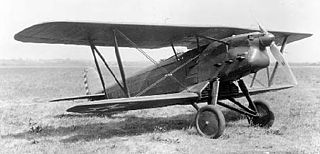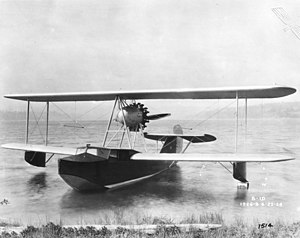
The P-1 Hawk was a 1920s open-cockpit biplane fighter aircraft of the United States Army Air Corps. An earlier variant of the same aircraft had been designated PW-8 prior to 1925.

Boeing XB-55 was a proposed Boeing aircraft designed to be a strategic bomber. The XB-55 was intended to be a replacement for the Boeing B-47 Stratojet in United States Air Force (USAF) service.

The Boeing XP-8 was a prototype American biplane fighter of the 1920s, notable for its unusual design incorporating the engine radiator into the lower wing.

The Boeing B-1 was a small biplane flying boat designed by William Boeing shortly after World War I.

The Bartel BM 5, initially known as M.5 was a Polish biplane advanced trainer used from 1930 to 1939 by the Polish Air Force, manufactured in the Samolot factory in Poznań.

The Breda A.4 was a biplane trainer produced in Italy in the mid-1920s. It was of conventional configuration with a two-bay unstaggered wing cellule and seating for the pilot and instructor in tandem open cockpits. Apart from civil use, the A.4 was also adopted by the Regia Aeronautica as a trainer. At least some examples were produced in floatplane configuration as the A.4idro.

The Cierva C.8 was an experimental autogyro built by Juan de la Cierva in England in 1926 in association with Avro. Like Cierva's earlier autogyros, the C.8s were based on existing fixed-wing aircraft fuselages – in this case, the Avro 552.

The International F-17 Sportsman was a 1920s American three-seat open-cockpit biplane designed and manufactured by the International Aircraft Corporation in Long Beach, California and Cincinnati, Ohio. 107 aircraft were built, 77 of them at Cincinnati.

The PZL.4 was a Polish three-engine passenger aircraft for 10 passengers, built in PZL factory in 1932, which remained a prototype. It was the first Polish-designed and produced multi-engine plane.

The Canadian Vickers Vista was a Canadian-designed single-seat flying boat.

The Boeing Model 204 was an American biplane, pusher configuration flying-boat aircraft built by Boeing in 1929. Externally, the 204 looked identical to the Boeing Model 6E, but a number of internal changes, including increasing the passenger capacity to four, gave it a new type certificate and model number.

The Boeing Model 81 was an American training aircraft built by Boeing in 1928. The Model 81 was a development of the Model 64. It was powered by a newly developed engine, the 125 hp Fairchild-Caminez 4-cylinder radial engine. Operating at a much lower rpm than most engines it required the use of a large high-pitch propeller.

The Aichi E10A was a Japanese night reconnaissance flying boat of the 1930s. A single-engined biplane, 15 were built for the Imperial Japanese Navy as the Type 96 Night Reconnaissance Seaplane, serving from 1936 but were retired in 1941 before the Attack on Pearl Harbor.
The InterPlane Griffon is a single seat, high wing, single engine, pusher configuration, tricycle gear ultralight aircraft, that was produced in kit form from InterPlane Aircraft of Zbraslavice, Czech Republic.

The Boeing XPB was an American twin-engined biplane long-range patrol flying boat of the 1920s. A single example was built for the United States Navy.

The PWS-11 was a Polish aerobatic and trainer aircraft, developed in 1928-1929 by PWS, which remained a prototype.
The Star Flight Starfire is the first aircraft in a large family of American ultralight aircraft that was designed by Dick Turner and produced by Star Flight Manufacturing, introduced in 1979. The aircraft were all supplied as kits for amateur construction.

The Curtiss CA-1 was an American five-seat biplane amphibian designed by Frank Courtney and built by Curtiss-Wright at St Louis, Missouri.

The Laird LC-B was a three seat, single-engined biplane, built for private owners in the U.S. in the late 1920s and offering a variety of engines. About 35 had been built before production ceased in the mid-1930s. Two have been restored to flight.

The Ireland Neptune was a four or five place pusher configuration biplane sold in flying boat and amphibian versions. Designed in the U.S. and first flown in 1927, well over 50 were built.




















